Deep-sea gigantism
In zoology, deep-sea gigantism, also known as abyssal gigantism, is the tendency for species of invertebrates and other deep-sea dwelling animals to be larger than their shallower-water relatives. Proposed explanations for this type of gigantism include colder temperature, food scarcity, and reduced predation pressure in the deep sea. The inaccessibility of abyssal habitats has hindered the study of this topic.

Taxonomic range
In marine crustaceans, the trend of increasing size with depth has been observed in mysids, euphausiids, decapods, isopods, and amphipods.[1] Non-arthropods in which deep-sea gigantism has been observed are cephalopods, cnidarians, and eels from the order Anguilliformes.[2]
Other [animals] attain under them gigantic proportions. It is especially certain crustacea which exhibit this latter peculiarity, but not all crustacea, for the crayfish like forms in the deep sea are of ordinary size. I have already referred to a gigantic Pycnogonid [sea spider] dredged by us. Mr. Agassiz dredged a gigantic Isopod eleven inches in length. We also dredged a gigantic Ostracod. For over 125 years, scientists have contemplated the extreme size of Bathynomus giganteus. – Henry Nottidge Moseley, 1880[3]
Examples of deep-sea gigantism include the big red jellyfish[4], the giant isopod,[3] giant ostracod,[3] the giant sea spider,[3] the giant amphipod, the Japanese spider crab, the giant oarfish, the deepwater stingray, the seven-arm octopus,[5], and a number of squid species: the colossal squid (up to 14 m in length),[6] the giant squid (up to 12 m),[6] Onykia robusta, Taningia danae, Galiteuthis phyllura, Kondakovia longimana, and the bigfin squid.
Deep-sea gigantism is not generally observed in the meiofauna (organisms that pass through a 1 mm mesh), which actually exhibit the reverse trend of decreasing size with depth.[7]
Explanations
Lower temperature
In crustaceans, it has been proposed that the explanation for the increase in size with depth is similar to that for the increase in size with latitude (Bergmann's rule): both trends involve increasing size with decreasing temperature.[1] The trend with latitude has been observed in some of the same groups, both in comparisons of related species as well as within widely distributed species.[1] Decreasing temperature is thought to result in increased cell size and increased life span (the latter also being associated with delayed sexual maturity[7]), both of which lead to an increase in maximum body size (continued growth throughout life is characteristic of crustaceans).[1] In Arctic and Antarctic seas where there is a reduced vertical temperature gradient, there is also a reduced trend towards increased body size with depth, arguing against hydrostatic pressure being an important parameter.[1]
Temperature does not appear to have a similar role in influencing the size of giant tube worms. Riftia pachyptila, which lives in hydrothermal vent communities at ambient temperatures of 2–30 °C,[8] reaches lengths of 2.7 m, comparable to those of Lamellibrachia luymesi, which lives in cold seeps. The former, however, has rapid growth rates and short life spans of about 2 years,[9] while the latter is slow growing and may live over 250 years.[10]
Food scarcity
Food scarcity at depths greater than 400 m is also thought to be a factor, since larger body size can improve ability to forage for widely scattered resources.[7] In organisms with planktonic eggs or larvae, another possible advantage is that larger offspring, with greater initial stored food reserves, can drift for greater distances.[7] As an example of adaptations to this situation, giant isopods gorge on food when available, distending their bodies to the point of compromising ability to locomote;[11] they can also survive 5 years without food in captivity.[12][13]
According to Kleiber's rule,[14] the larger an animal gets, the more efficient its metabolism becomes; i.e., an animal's metabolic rate scales to roughly the ¾ power of its mass. Under conditions of limited food supply, this may provide additional benefit to large size.
Reduced predation pressure
An additional possible influence is reduced predation pressure in deeper waters.[15] A study of brachiopods found that predation was nearly an order of magnitude less frequent at the greatest depths than in shallow waters.[15]
Gallery
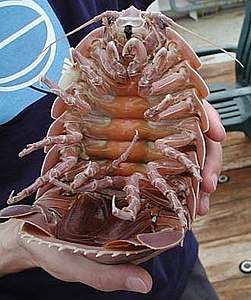
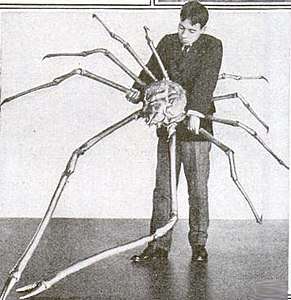
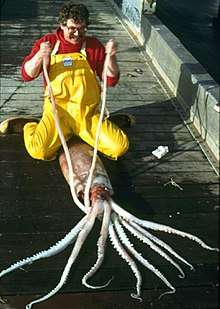

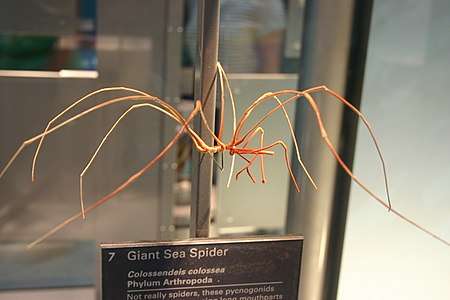 A Colossendeis colossea sea spider, displayed at the Smithsonian.
A Colossendeis colossea sea spider, displayed at the Smithsonian.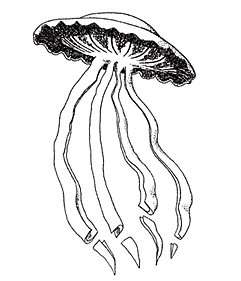
 A deepwater stingray, which can reach up to 2.7 meters by 1.5 meters in size.
A deepwater stingray, which can reach up to 2.7 meters by 1.5 meters in size.
References
- Timofeev, S. F. (2001). "Bergmann's Principle and Deep-Water Gigantism in Marine Crustaceans". Biology Bulletin (Russian Version, Izvestiya Akademii Nauk, Seriya Biologicheskaya). 28 (6): 646–650 (Russian version, 764–768). doi:10.1023/A:1012336823275.
- Hanks, Micah. "Deep Sea Gigantism: Curious Cases of Mystery Giant Eels". MysteriousUniverse. Retrieved 5 May 2019.
- McClain, Craig. "Why isn't the Giant Isopod larger?". Deep Sea News. Retrieved 1 March 2018.
- Smithsonian Oceans. "Big Red Jellyfish". Smithsonian Oceans. Retrieved 5 May 2019.
- Hoving, H. J. T.; Haddock, S. H. D. (2017-03-27). "The giant deep-sea octopus Haliphron atlanticus forages on gelatinous fauna". Scientific Reports. 7: 44952. doi:10.1038/srep44952. PMC 5366804. PMID 28344325.
- Anderton, Jim (22 February 2007). "Amazing specimen of world's largest squid in NZ". New Zealand Government. Archived from the original on 23 May 2010.
- Gad, G. (2005). "Giant Higgins-larvae with paedogenetic reproduction from the deep sea of the Angola Basin? Evidence for a new life cycle and for abyssal gigantism in Loricifera?". Organisms Diversity & Evolution. 5: 59–75. doi:10.1016/j.ode.2004.10.005.
- Bright, M.; Lallier, F. H. (2010). "The biology of vestimentiferan tubeworms" (PDF). Oceanography and Marine Biology: An Annual Review. Oceanography and Marine Biology - an Annual Review. Taylor & Francis. 48: 213–266. doi:10.1201/ebk1439821169-c4. ISBN 978-1-4398-2116-9. Archived from the original (PDF) on 2013-10-31. Retrieved 2013-10-30.
- Lutz, R. A.; Shank, T. M.; Fornari, D. J.; Haymon, R. M.; Lilley, M. D.; Von Damm, K. L.; Desbruyeres, D. (1994). "Rapid growth at deep-sea vents". Nature. 371 (6499): 663. doi:10.1038/371663a0.
- MacDonald, Ian R. (2002). "Stability and Change in Gulf of Mexico Chemosynthetic Communities" (PDF). MMS. Retrieved 2013-10-30.
- Briones-Fourzán, Patricia; Lozano-Alvarez, Enrique (1991). "Aspects of the biology of the giant isopod Bathynomus giganteus A. Milne Edwards, 1879 (Flabellifera: Cirolanidae), off the Yucatan Peninsula". Journal of Crustacean Biology. 11 (3): 375–385. doi:10.2307/1548464. JSTOR 1548464.
- Gallagher, Jack (2013-02-26). "Aquarium's deep-sea isopod hasn't eaten for over four years". The Japan Times. Retrieved 2013-05-21.
- "I Won't Eat, You Can't Make Me! (And They Couldn't)". NPR. February 22, 2014. Retrieved February 23, 2014.
- Kleiber, M. (1947). "Body Size and Metabolic Rate". Physiological Reviews. 27 (4): 511–541. doi:10.1152/physrev.1947.27.4.511. PMID 20267758.
- Harper, E. M.; Peck, L. S. (2016). "Latitudinal and depth gradients in marine predation pressure". Global Ecology and Biogeography. 25 (6): 670–678. doi:10.1111/geb.12444.
